Related Research Articles

Caterina di Jacopo di Benincasa, known as Catherine of Siena, was an Italian mystic and pious laywoman who engaged in papal and Italian politics through extensive letter-writing and advocacy. Canonized in 1461, she is revered as a saint and as a Doctor of the Church due to her extensive theological authorship. She is also considered to have influenced Italian literature.

Venice is a city in northeastern Italy and the capital of the Veneto region. It is built on a group of 126 islands that are separated by expanses of open water and by canals; portions of the city are linked by 472 bridges. The islands are in the shallow Venetian Lagoon, an enclosed bay lying between the mouths of the Po and the Piave rivers. In 2020, around 258,685 people resided in greater Venice or the Comune di Venezia, of whom around 51,000 live in the historical island city of Venice and the rest on the mainland (terraferma). Together with the cities of Padua and Treviso, Venice is included in the Padua-Treviso-Venice Metropolitan Area (PATREVE), which is considered a statistical metropolitan area, with a total population of 2.6 million.

Irene Joan Marion Sims was an English actress, best remembered for her roles in the Carry On franchise, appearing in 24 of the films.

Giovanni Bellini was an Italian Renaissance painter, probably the best known of the Bellini family of Venetian painters. He was raised in the household of Jacopo Bellini, formerly thought to have been his father, but now that familial generational relationship is questioned. An older brother, Gentile Bellini was more highly regarded than Giovanni during his lifetime, but the reverse is true today. His brother-in-law was Andrea Mantegna.

Torcello is a sparsely populated island at the northern end of the Venetian Lagoon, in north-eastern Italy. It was first settled in 452 CE and has been referred to as the parent island from which Venice was populated. It was a town with a cathedral and bishops before St Mark's Basilica was built.

The Isabella Stewart Gardner Museum is an art museum in Boston, Massachusetts, which houses significant examples of European, Asian, and American art. Its collection includes paintings, sculpture, tapestries, and decorative arts. It was founded by Isabella Stewart Gardner, whose will called for her art collection to be permanently exhibited "for the education and enjoyment of the public forever."
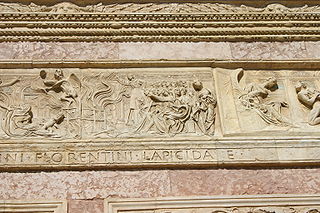
A bonfire of the vanities is a burning of objects condemned by religious authorities as occasions of sin. The phrase itself usually refers to the bonfire of 7 February 1497, when supporters of the Dominican friar Girolamo Savonarola collected and burned thousands of objects such as cosmetics, art, and books in the public square of Florence, Italy, on the occasion of Shrove Tuesday, martedí grasso.

Volterra is a walled mountaintop town in the Tuscany region of Italy. Its history dates from before the 8th century BC and it has substantial structures from the Etruscan, Roman, and Medieval periods.

Elke Sommer is a German actress. She appeared in numerous films in her heyday throughout the 1960s and 1970s, including roles in The Pink Panther sequel A Shot in the Dark (1964), the Bob Hope comedy Boy, Did I Get a Wrong Number! (1966), Agatha Christie's And Then There Were None (1974), and the British Carry On series in Carry On Behind (1975).

Venetian glass is glassware made in Venice, typically on the island of Murano near the city. Traditionally it is made with a soda–lime "metal" and is typically elaborately decorated, with various "hot" glass-forming techniques, as well as gilding, enamel, or engraving. Production has been concentrated on the Venetian island of Murano since the 13th century. Today Murano is known for its art glass, but it has a long history of innovations in glassmaking in addition to its artistic fame—and was Europe's major center for luxury glass from the High Middle Ages to the Italian Renaissance. During the 15th century, Murano glassmakers created cristallo—which was almost transparent and considered the finest glass in the world. Murano glassmakers also developed a white-colored glass that looked like porcelain. They later became Europe's finest makers of mirrors.

Lino Tagliapietra is an Italian glass artist originally from Venice, who has also worked extensively in the United States. As a teacher and mentor, he has played a key role in the international exchange of glassblowing processes and techniques between the principal American centers and his native Murano, "but his influence is also apparent in China, Japan, and Australia—and filters far beyond any political or geographic boundaries."
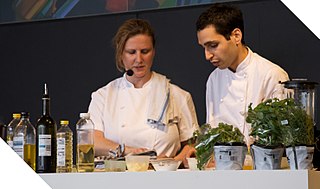
Angela Maria Hartnett is an English Michelin-starred chef. A protégée of Gordon Ramsay who became well known by her appearances on British television, she was Chef-Patron at Angela Hartnett at The Connaught in London. Currently, she is Chef-Patron for Murano in Mayfair, Café Murano in St James's & Covent Garden and Cucina Angelina in Courchevel (France).

Pauly & C. - Compagnia Venezia Murano is one of the oldest glass factories of Murano: it was founded more than 150 years ago. The company produces glass art, most notably Roman murrine, mosaics and chandeliers.

Paolo Venini emerged as one of the leading figures in the production of Murano glass and an important contributor to twentieth century Italian design. He is known for having founded the eponymous Venini & C. glassworks.
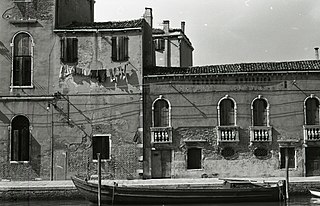
Barovier & Toso is an Italian company that specializes in Venetian glass.

Margarita Luti was the mistress and model of Raphael. The story of their love has become "the archetypal artist–model relationship of Western tradition", yet little is known of her life. Of her, Flaubert wrote, in his Dictionary of Received Ideas, "Fornarina. She was a beautiful woman. That is all you need to know."

Giovanni Antonio Moschini or Giannantonio Moschini was an Italian author and Roman Catholic Somascan priest. He was an art critic who wrote mainly about art and architecture in Venice and the Veneto.
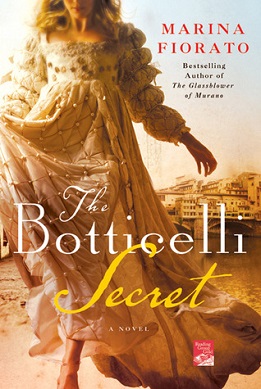
The Botticelli Secret is a 2010 historical-mystery-detective novel written by Marina Fiorato in the vein of code adventures such as The Da Vinci Code by Dan Brown. Set in the 15th century throughout the Italian states, the protagonists are part-time model and full-time prostitute Luciana Vetra and monk Father Guido della Torre as they are thrown together in Florence and chased across the country through the likes of Venice, Milan and Rome. The title of the novel refers to a conspiracy that Luciana has stumbled across, and a code in the famous painting La Primavera by Renaissance artist Sandro Botticelli.
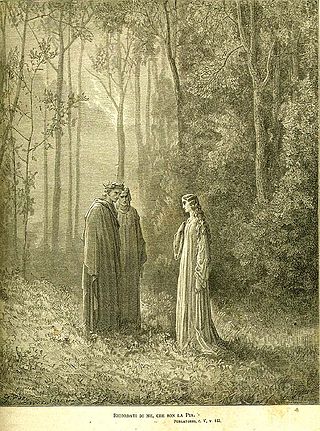
Pia de' Tolomei was an Italian noblewoman from Siena identified as "la Pia," a minor character in Dante's Divine Comedy who was murdered by her husband. Her brief presence in the poem has inspired many works in art, music, literature, and cinema. Her character in the Divine Comedy is noted for her compassion and serves a greater program among the characters in her canto, as well as the female characters in the entire poem.

Italo-Byzantine is a style term in art history, mostly used for medieval paintings produced in Italy under heavy influence from Byzantine art. It initially covers religious paintings copying or imitating the standard Byzantine icon types, but painted by artists without a training in Byzantine techniques. These are versions of Byzantine icons, most of the Madonna and Child, but also of other subjects; essentially they introduced the relatively small portable painting with a frame to Western Europe. Very often they are on a gold ground. It was the dominant style in Italian painting until the end of the 13th century, when Cimabue and Giotto began to take Italian, or at least Florentine, painting into new territory. But the style continued until the 15th century and beyond in some areas and contexts.
References
- 1 2 Monica Bottino, "La scrittrice inglese che ama il Rinascimento genovese", il Giornale , 25 November 2011 (in Italian)
- 1 2 3 "Dales Folk: Best-selling writer Marina happy to be back in town", Craven Herald & Pioneer , 10 January 2009.
- ↑ Marina Fiorato at the IMDb
- ↑ Javier Espinoza, "Faces in the News: Art Imitating J.K. Rowling: Marina Fiorato was inspired by the Harry Potter author to write her novel in cafes, and it's now a best seller", Forbes.com, 9 December 2008.
- ↑ "Marina Fiorato: novelist who wrote in cafés earns £250,000 advance", The Telegraph , 16 May 2010.